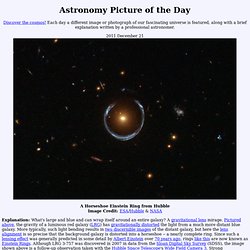

Neil Godwin
2011 October 26 - In Through and Beyond Saturns Rings. Discover the cosmos!
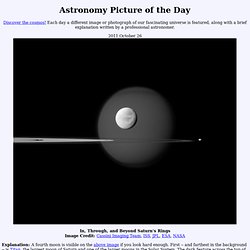
Each day a different image or photograph of our fascinating universe is featured, along with a brief explanation written by a professional astronomer. 2011 October 26 In, Through, and Beyond Saturn's Rings Image Credit: Cassini Imaging Team, ISS, JPL, ESA, NASA Explanation: A fourth moon is visible on the above image if you look hard enough. First -- and farthest in the background -- is Titan, the largest moon of Saturn and one of the larger moons in the Solar System. Tomorrow's picture: open space Authors & editors: Robert Nemiroff (MTU) & Jerry Bonnell (UMCP)NASA Official: Phillip Newman Specific rights apply.NASA Web Privacy Policy and Important NoticesA service of:ASD at NASA / GSFC& Michigan Tech. 2011 October 23 - Jupiter's Clouds from New Horizons. Discover the cosmos! Each day a different image or photograph of our fascinating universe is featured, along with a brief explanation written by a professional astronomer. 2011 October 23 Jupiter's Clouds from New Horizons Image Credit: NASA , Johns Hopkins U.
APL , SWRI Explanation: The New Horizons spacecraft took some stunning images of Jupiter on its way out to Pluto. Astronomy Picture of the Day. 2012 September 17 - A Solar Filament Erupts. Discover the cosmos!
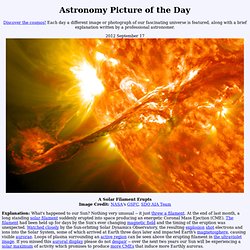
Each day a different image or photograph of our fascinating universe is featured, along with a brief explanation written by a professional astronomer. 2012 September 17 Explanation: What's happened to our Sun? Nothing very unusual -- it just threw a filament. At the end of last month, a long standing solar filament suddenly erupted into space producing an energetic Coronal Mass Ejection (CME). World's Largest Professional Network.
Astronomy picture of the day. 2011 November 16 - NGC 7822 in Cepheus. Discover the cosmos!

Each day a different image or photograph of our fascinating universe is featured, along with a brief explanation written by a professional astronomer. 2011 November 16 NGC 7822 in Cepheus Image Credit & Copyright: Manuel Fernández Suarez Explanation: Hot, young stars and cosmic pillars of gas and dust seem to crowd into NGC 7822. At the edge of a giant molecular cloud toward the northern constellation Cepheus, the glowing star forming region lies about 3,000 light-years away.
2011 November 17 - Pleiades to Hyades. Discover the cosmos!
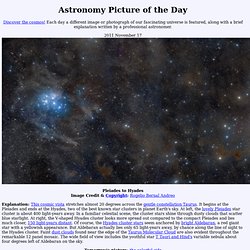
Each day a different image or photograph of our fascinating universe is featured, along with a brief explanation written by a professional astronomer. 2011 November 17 Pleiades to Hyades Image Credit & Copyright: Rogelio Bernal Andreo Explanation: This cosmic vista stretches almost 20 degrees across the gentle constellation Taurus. It begins at the Pleiades and ends at the Hyades, two of the best known star clusters in planet Earth's sky.
Tomorrow's picture: the colorful side. 2011 November 20 - W5: Pillars of Star Formation. Discover the cosmos!
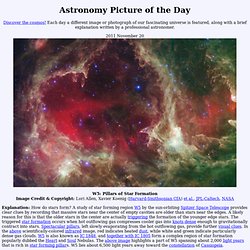
Each day a different image or photograph of our fascinating universe is featured, along with a brief explanation written by a professional astronomer. 2011 November 20 W5: Pillars of Star Formation Image Credit & Copyright: Lori Allen, Xavier Koenig (Harvard-Smithsonian CfA) et al., JPL-Caltech, NASA Explanation: How do stars form? A study of star forming region W5 by the sun-orbiting Spitzer Space Telescope provides clear clues by recording that massive stars near the center of empty cavities are older than stars near the edges. 2012 February 8 - Enceladus Backlit by Saturn. Discover the cosmos!
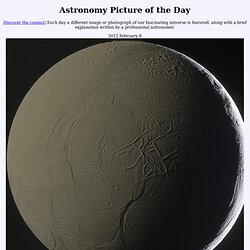
Each day a different image or photograph of our fascinating universe is featured, along with a brief explanation written by a professional astronomer. 2012 February 8. Astronomy Picture of the Day. Discover the cosmos!

Each day a different image or photograph of our fascinating universe is featured, along with a brief explanation written by a professional astronomer. 2016 April 15 Mercury and Crescent Moon Set Image Credit & Copyright: Miguel Claro (TWAN, Dark Sky Alqueva) Explanation: Innermost planet Mercury and a thin crescent Moon are never found far from the Sun in planet Earth's skies. Taken near dusk on April 8, this colorful evening skyscape shows them both setting toward the western horizon just after the Sun. Tomorrow's picture: Heliopause Electrostatic Rapid Transit System Authors & editors: Robert Nemiroff (MTU) & Jerry Bonnell (UMCP)NASA Official: Phillip Newman Specific rights apply.NASA Web Privacy Policy and Important NoticesA service of:ASD at NASA / GSFC& Michigan Tech. 2011 December 26 - A Raging Storm System on Saturn. Discover the cosmos!

Each day a different image or photograph of our fascinating universe is featured, along with a brief explanation written by a professional astronomer. 2011 December 26 A Raging Storm System on Saturn Image Credit: Cassini Imaging Team, SSI, JPL, ESA, NASA Explanation: It is one of the largest and longest lived storms ever recorded in our Solar System. First seen late last year, the above cloud formation in the northern hemisphere of Saturn started larger than the Earth and soon spread completely around the planet. Fun Quiz: Celestial or Cellular -- can you tell the difference?
2011 November 24 - Caught in the Afterglow. Discover the cosmos!

Each day a different image or photograph of our fascinating universe is featured, along with a brief explanation written by a professional astronomer. 2011 November 24 Caught in the Afterglow Illustration Credit: ESO, L. Calçada - Research Team: Sandra Savaglio (MPE) et al. Explanation: In this artist's illustration, two distant galaxies formed about 2 billion years after the big bang are caught in the afterglow of GRB090323, a gamma-ray burst seen across the Universe. 2011 December 21 - A Horseshoe Einstein Ring from Hubble. Discover the cosmos!
